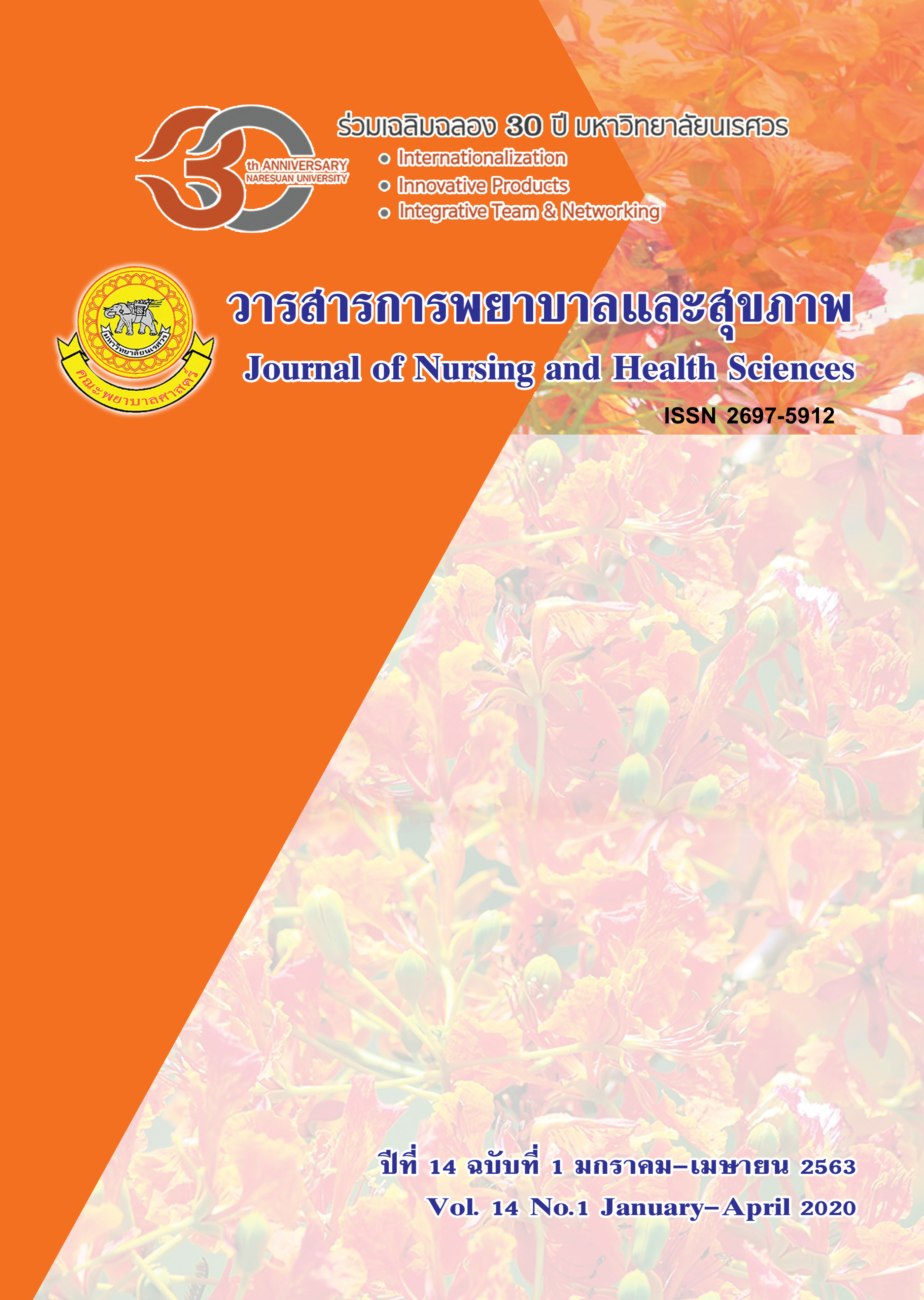Caring among Nurses Working in a Rich Technological Environment
Main Article Content
Abstract
The objective of this mixed methods design studywas to explorecaring levels and caringperspectives of nurses working in intensive care units. The samples consisted of nurses who passed the special nursing course training in critical care nursing from the Faculty of Nursing, Naresuan University, and nurses working at critical care units at Naresuan University Hospital. The number of samples used in the quantitative study part was 205 cases and the number of informants used in the qualitative study part was 30 cases. The tools used in the study were 1) the demographic data questionnaire, 2) the questionnaire of the Technological Competency as Caring in Nursing Inventory (TCCNI) developed by Locsin (Locsin, 2005), which was translated from English to Thai language and was done a back translation into English by three experts who know well both English and Thai languages, and the Cronbach's alpha was 0.89, and 3) the semi-structured in-depth interview which was done content validity by three experts. Quantitative data to study caring levels among nurses working in a rich technological environment was analyzedwith mean and standard deviation statistics. Qualitative data was analyzed by using content analysis in order to study caring perspectives among nurses workinga rich technological environment. After that, the results from the qualitative and quantitative data analysis wasinterpreted together. The results of the quantitative study revealed that the samples had a high score of caring in a rich technological environment with an average of 4.5 and standard deviation of 0.4. The results of the qualitative study showed that the informants identified three perspectives: providing comfort and safe care, psychosocial care, and using health technologies correctly and effectively. This research will be evidence to confirm that caring can happen well while nurses provide nursing practice in a rich technological environment.
Article Details
References
Ansell, H., Meyer, A., & Thompson, S. (2015). Technologyand the issues facing nursing assessment. British Journal of Nursing, 24(17), 886-889.
Bailey, D. (2009). Caring defined: a comparison and analysis. International Journal for Human Caring, 13(1), 16-31.
Biswas, S. R., Kongsuwan, W., & Matchim, Y. (2016). Technological competency as caring in nursing as perceived by ICU nurses in Bangladesh and its related factors. Songklanagarind Journal of Nursing, 36(1), 1-20. [In Thai].
Blum, C. A., Hickman, C., Parcells, D. A., & Locsin, R. (2010). Teaching caring nursing to RNBSN students using simulation technology. International Journal for Human Caring, 14(2), 41-50.
Boykin, A., & Schoenhofer, S. O. (2001). Nursing as caring: a model for transforming practice. Sudbury, MA: Jones and Bartlett Publishers.
Eggenberger, T. L., & Keller, K. B. (2008). Grounding nursing simulations in caring: An innovative approach. International Journal for Human Caring, 12(2), 42-46.
Hayes, J., Merrill, A., Clukey, L., & Curtis, D. (2010). Family-centered trauma care: is it caring? International Journal of Human Caring, 14, 7-10.
Johansson L., Bergbom, I., Persson, W. K., Ryherd, E, & Lindahl, B. (2012). The sound environment in an ICU patient room — a content analysis of sound levels and patient experiences. Intensive Critical Care Nurses, 28, 269-79.
Limumnoilap, S. (2013). Critical illness and nursing care. In S. Limumnoilap and C. Thumnong (Eds.). Nursing care for patients with critical illness: critical care nursing. (7th ed., pp. 1-28). KhonKhan: Khangnanawittaya Press. [In Thai].
Locsin, R. C. (2005). Technological competency as caring in nursing: a model for practice. IN: Sigma Theta Tau International.
Locsin, R. C. (2018). Technologic competence as caring in critical care nursing. In R. C., Locsin & W. Kongsuwan. (Eds.). The Evolution of the Theory of Technological Competency as Caring in Nursing: A Middle-Range Theory of Nursing, (pp. 13-19). SongKhla: Chanmuang press.
McGrath, M. (2008). The challenges of caring in a technological environment: critical care nurses’ experiences. Journal of Clinical Nursing, 1096-1104.
Modic, M. B., Siedlecki, S. L., Quinn Griffin, M. T., & Fitzpatrick, J. J. (2014). Caring behaviors: Perceptions of Acute care nurses and hospitalized patients with diabetes. Journal of Patient Experience, 1(1), 26-30.
Nantz, S., & Hines, A. (2015). Trauma patients’ family members’ perceptions of nurses’ caring behaviors. Journal of Trauma Nursing, 22(5), 249-254.
Piyasiripan, K. (2001). Caring behaviors of nurses as percieved by patients in intensive care units. Master Thesis (Adult Nursing), Chiang Mai University, Chiang Mai. [In Thai].
Price, A. M. (2013). Caring and technology in an intensive care unit: an ethnographic study. British Association of Critical Care Nurses, 18(6), 278-287.
Rerksadayut, P. (2013). Caring behaviors of perioperative nurses and related factors as perceived by perioperative nurses. Master Thesis (Adult Nursing), Prince of Songkla University, Songkla. [In Thai].
Srisatidnarakul, B. (2012). Development and Validation of Research Instruments: Psychometric Properties. Bangkok: Chulalongkorn University. [In Thai]


